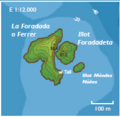Columbretes Islands facts for kids
Quick facts for kids
Columbretes
Les Columbretes
|
|
|---|---|
|
Islands
|
|

Columbretes Islands map
|
|
| Country | |
| Autonomous community | |
| Province | Castellón |
| Comarca | Plana Alta |
| Judicial district | Castellón de la Plana |
| Area | |
| • Total | 0.19 km2 (0.07 sq mi) |
| Highest elevation | 67 m (220 ft) |
| Population
(2009)
|
|
| • Total | no permanent population |
| Time zone | UTC+1 (CET) |
| • Summer (DST) | UTC+2 (CEST) |
| Postal code |
12100
|
The Columbretes Islands (also called Les Columbretes in Valencian) are a group of small, uninhabited islands. They are made from volcanoes and are located in the Mediterranean Sea. You can find them about 49 kilometers (30 miles) off the coast of Oropesa, Spain.
These islands are part of Castellón de la Plana in the Valencian Community. The main islands are Illa Grossa, La Ferrera, La Foradada, and El Carallot. All the islands together cover an area of about 0.19 square kilometers (0.07 square miles). The highest point is 67 meters (220 feet) above sea level.
Illa Grossa is the biggest island and is shaped like a half-circle. This shape comes from an old volcano crater. There are no regular buildings on the island. You will only find a lighthouse from the 1800s, a small dock, and living quarters for the scientists who work there.
Contents
How the Columbretes Islands Were Formed
The Columbretes Islands were created by volcanoes. The largest island, Columbrete Grande, was formed during four volcanic eruptions. These eruptions happened between 1 million and 300,000 years ago. The islands are made of volcanic rock that formed as the Valencia Trough (a deep part of the sea) opened up.
A Look Back: History of the Islands
People have known about these islands since ancient times. Both the Greeks and Romans wrote about them. They were amazed by the huge number of snakes living there. The islands were called Ophiusa by the Greeks and Colubraria by the Romans. Both names mean "serpent" or "snake." The current name, Columbretes, also comes from the Latin word for "snake," which is "Coluber."
In the mid-1800s, a lighthouse was built on Illa Grossa. A few people then moved to the island to take care of the lighthouse. They also helped stop smugglers who used the islands as a hiding place.
Animals like pigs were brought to the islands. People also burned the natural bushes on the lighthouse island. This was done partly for farming and also to get rid of the many snakes. Because of these changes, the snakes died out by the end of the 1800s. Today, the only reminder of the snakes is a stuffed viper from the Columbretes. You can see it in Madrid's Natural Science Museum.
Island Groups of Columbretes
The Columbretes Islands are divided into four main groups. Each group is named after its largest island.
- L'Illa Grossa group is the largest group. It includes the main island, Columbret Gran (Illa Grossa).
- La Ferrera group is another important group. Its biggest island is La Ferrera (Malaspina).
- La Foradada group contains the island La Foradada.
- El Carallot group is the smallest. Its main island is El Carallot (Galiano).
A Special Place for Nature
Since 1988, the Columbretes Islands have been a protected wildlife reserve. They are a perfect spot for many sea birds to lay their eggs and raise their young.
One important bird found here is the Audouin's gull. The group of Audouin's gulls on these islands is one of the biggest in the world. It is very important for helping this species recover. The islands are also home to a large group of Eleanora's falcons in Spain. During spring and autumn, many different bird species stop at the islands to rest during their long bird migrations.
Because the islands are so isolated, they have unique animals and plants. There is a special type of small lizard called Podarcis hispanicus atratus that only lives here. There is also a unique plant called Lobularia maritima.
After the islands became a Natural Park, the pigs that were brought there were removed. The lighthouse now works automatically, so fewer people need to be on the islands. This helps protect the wildlife.
The waters around the islands are also very important for nature. This underwater area covers about 400 square kilometers (154 square miles). It is a Marine reserve since 1990. Many different kinds of sea creatures live and grow there without being disturbed.
Images for kids
See also
 In Spanish: Islas Columbretes para niños
In Spanish: Islas Columbretes para niños






